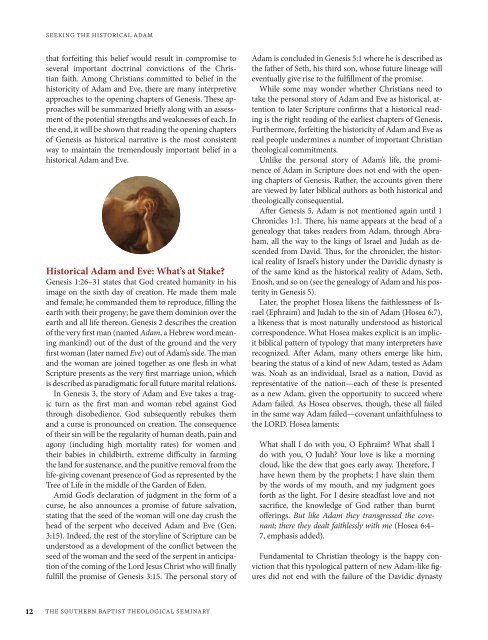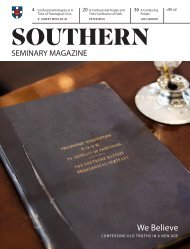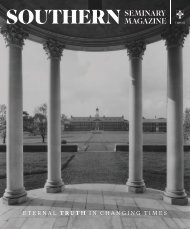Southern Seminary Magazine (Vol 90.1) The Light of Truth: Apologetics in the 21st Century
Create successful ePaper yourself
Turn your PDF publications into a flip-book with our unique Google optimized e-Paper software.
seek<strong>in</strong>g <strong>the</strong> historical adam<br />
that forfeit<strong>in</strong>g this belief would result <strong>in</strong> compromise to<br />
several important doctr<strong>in</strong>al convictions <strong>of</strong> <strong>the</strong> Christian<br />
faith. Among Christians committed to belief <strong>in</strong> <strong>the</strong><br />
historicity <strong>of</strong> Adam and Eve, <strong>the</strong>re are many <strong>in</strong>terpretive<br />
approaches to <strong>the</strong> open<strong>in</strong>g chapters <strong>of</strong> Genesis. <strong>The</strong>se approaches<br />
will be summarized briefly along with an assessment<br />
<strong>of</strong> <strong>the</strong> potential strengths and weaknesses <strong>of</strong> each. In<br />
<strong>the</strong> end, it will be shown that read<strong>in</strong>g <strong>the</strong> open<strong>in</strong>g chapters<br />
<strong>of</strong> Genesis as historical narrative is <strong>the</strong> most consistent<br />
way to ma<strong>in</strong>ta<strong>in</strong> <strong>the</strong> tremendously important belief <strong>in</strong> a<br />
historical Adam and Eve.<br />
Historical Adam and Eve: What’s at Stake?<br />
Genesis 1:26–31 states that God created humanity <strong>in</strong> his<br />
image on <strong>the</strong> sixth day <strong>of</strong> creation. He made <strong>the</strong>m male<br />
and female; he commanded <strong>the</strong>m to reproduce, fill<strong>in</strong>g <strong>the</strong><br />
earth with <strong>the</strong>ir progeny; he gave <strong>the</strong>m dom<strong>in</strong>ion over <strong>the</strong><br />
earth and all life <strong>the</strong>reon. Genesis 2 describes <strong>the</strong> creation<br />
<strong>of</strong> <strong>the</strong> very first man (named Adam, a Hebrew word mean<strong>in</strong>g<br />
mank<strong>in</strong>d) out <strong>of</strong> <strong>the</strong> dust <strong>of</strong> <strong>the</strong> ground and <strong>the</strong> very<br />
first woman (later named Eve) out <strong>of</strong> Adam’s side. <strong>The</strong> man<br />
and <strong>the</strong> woman are jo<strong>in</strong>ed toge<strong>the</strong>r as one flesh <strong>in</strong> what<br />
Scripture presents as <strong>the</strong> very first marriage union, which<br />
is described as paradigmatic for all future marital relations.<br />
In Genesis 3, <strong>the</strong> story <strong>of</strong> Adam and Eve takes a tragic<br />
turn as <strong>the</strong> first man and woman rebel aga<strong>in</strong>st God<br />
through disobedience. God subsequently rebukes <strong>the</strong>m<br />
and a curse is pronounced on creation. <strong>The</strong> consequence<br />
<strong>of</strong> <strong>the</strong>ir s<strong>in</strong> will be <strong>the</strong> regularity <strong>of</strong> human death, pa<strong>in</strong> and<br />
agony (<strong>in</strong>clud<strong>in</strong>g high mortality rates) for women and<br />
<strong>the</strong>ir babies <strong>in</strong> childbirth, extreme difficulty <strong>in</strong> farm<strong>in</strong>g<br />
<strong>the</strong> land for sustenance, and <strong>the</strong> punitive removal from <strong>the</strong><br />
life-giv<strong>in</strong>g covenant presence <strong>of</strong> God as represented by <strong>the</strong><br />
Tree <strong>of</strong> Life <strong>in</strong> <strong>the</strong> middle <strong>of</strong> <strong>the</strong> Garden <strong>of</strong> Eden.<br />
Amid God’s declaration <strong>of</strong> judgment <strong>in</strong> <strong>the</strong> form <strong>of</strong> a<br />
curse, he also announces a promise <strong>of</strong> future salvation,<br />
stat<strong>in</strong>g that <strong>the</strong> seed <strong>of</strong> <strong>the</strong> woman will one day crush <strong>the</strong><br />
head <strong>of</strong> <strong>the</strong> serpent who deceived Adam and Eve (Gen.<br />
3:15). Indeed, <strong>the</strong> rest <strong>of</strong> <strong>the</strong> storyl<strong>in</strong>e <strong>of</strong> Scripture can be<br />
understood as a development <strong>of</strong> <strong>the</strong> conflict between <strong>the</strong><br />
seed <strong>of</strong> <strong>the</strong> woman and <strong>the</strong> seed <strong>of</strong> <strong>the</strong> serpent <strong>in</strong> anticipation<br />
<strong>of</strong> <strong>the</strong> com<strong>in</strong>g <strong>of</strong> <strong>the</strong> Lord Jesus Christ who will f<strong>in</strong>ally<br />
fulfill <strong>the</strong> promise <strong>of</strong> Genesis 3:15. <strong>The</strong> personal story <strong>of</strong><br />
Adam is concluded <strong>in</strong> Genesis 5:1 where he is described as<br />
<strong>the</strong> fa<strong>the</strong>r <strong>of</strong> Seth, his third son, whose future l<strong>in</strong>eage will<br />
eventually give rise to <strong>the</strong> fulfillment <strong>of</strong> <strong>the</strong> promise.<br />
While some may wonder whe<strong>the</strong>r Christians need to<br />
take <strong>the</strong> personal story <strong>of</strong> Adam and Eve as historical, attention<br />
to later Scripture confirms that a historical read<strong>in</strong>g<br />
is <strong>the</strong> right read<strong>in</strong>g <strong>of</strong> <strong>the</strong> earliest chapters <strong>of</strong> Genesis.<br />
Fur<strong>the</strong>rmore, forfeit<strong>in</strong>g <strong>the</strong> historicity <strong>of</strong> Adam and Eve as<br />
real people underm<strong>in</strong>es a number <strong>of</strong> important Christian<br />
<strong>the</strong>ological commitments.<br />
Unlike <strong>the</strong> personal story <strong>of</strong> Adam’s life, <strong>the</strong> prom<strong>in</strong>ence<br />
<strong>of</strong> Adam <strong>in</strong> Scripture does not end with <strong>the</strong> open<strong>in</strong>g<br />
chapters <strong>of</strong> Genesis. Ra<strong>the</strong>r, <strong>the</strong> accounts given <strong>the</strong>re<br />
are viewed by later biblical authors as both historical and<br />
<strong>the</strong>ologically consequential.<br />
After Genesis 5, Adam is not mentioned aga<strong>in</strong> until 1<br />
Chronicles 1:1. <strong>The</strong>re, his name appears at <strong>the</strong> head <strong>of</strong> a<br />
genealogy that takes readers from Adam, through Abraham,<br />
all <strong>the</strong> way to <strong>the</strong> k<strong>in</strong>gs <strong>of</strong> Israel and Judah as descended<br />
from David. Thus, for <strong>the</strong> chronicler, <strong>the</strong> historical<br />
reality <strong>of</strong> Israel’s history under <strong>the</strong> Davidic dynasty is<br />
<strong>of</strong> <strong>the</strong> same k<strong>in</strong>d as <strong>the</strong> historical reality <strong>of</strong> Adam, Seth,<br />
Enosh, and so on (see <strong>the</strong> genealogy <strong>of</strong> Adam and his posterity<br />
<strong>in</strong> Genesis 5).<br />
Later, <strong>the</strong> prophet Hosea likens <strong>the</strong> faithlessness <strong>of</strong> Israel<br />
(Ephraim) and Judah to <strong>the</strong> s<strong>in</strong> <strong>of</strong> Adam (Hosea 6:7),<br />
a likeness that is most naturally understood as historical<br />
correspondence. What Hosea makes explicit is an implicit<br />
biblical pattern <strong>of</strong> typology that many <strong>in</strong>terpreters have<br />
recognized. After Adam, many o<strong>the</strong>rs emerge like him,<br />
bear<strong>in</strong>g <strong>the</strong> status <strong>of</strong> a k<strong>in</strong>d <strong>of</strong> new Adam, tested as Adam<br />
was. Noah as an <strong>in</strong>dividual, Israel as a nation, David as<br />
representative <strong>of</strong> <strong>the</strong> nation—each <strong>of</strong> <strong>the</strong>se is presented<br />
as a new Adam, given <strong>the</strong> opportunity to succeed where<br />
Adam failed. As Hosea observes, though, <strong>the</strong>se all failed<br />
<strong>in</strong> <strong>the</strong> same way Adam failed—covenant unfaithfulness to<br />
<strong>the</strong> LORD. Hosea laments:<br />
What shall I do with you, O Ephraim? What shall I<br />
do with you, O Judah? Your love is like a morn<strong>in</strong>g<br />
cloud, like <strong>the</strong> dew that goes early away. <strong>The</strong>refore, I<br />
have hewn <strong>the</strong>m by <strong>the</strong> prophets; I have sla<strong>in</strong> <strong>the</strong>m<br />
by <strong>the</strong> words <strong>of</strong> my mouth, and my judgment goes<br />
forth as <strong>the</strong> light. For I desire steadfast love and not<br />
sacrifice, <strong>the</strong> knowledge <strong>of</strong> God ra<strong>the</strong>r than burnt<br />
<strong>of</strong>fer<strong>in</strong>gs. But like Adam <strong>the</strong>y transgressed <strong>the</strong> covenant;<br />
<strong>the</strong>re <strong>the</strong>y dealt faithlessly with me (Hosea 6:4–<br />
7, emphasis added).<br />
Fundamental to Christian <strong>the</strong>ology is <strong>the</strong> happy conviction<br />
that this typological pattern <strong>of</strong> new Adam-like figures<br />
did not end with <strong>the</strong> failure <strong>of</strong> <strong>the</strong> Davidic dynasty<br />
12 <strong>the</strong> sou<strong>the</strong>rn baptist <strong>the</strong>ological sem<strong>in</strong>ary






